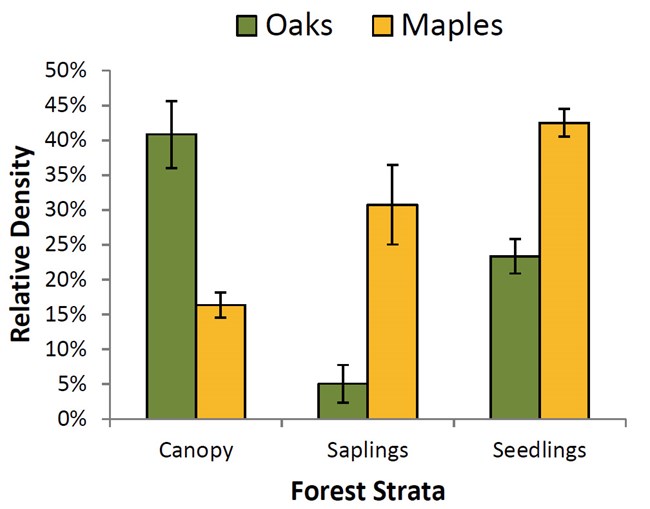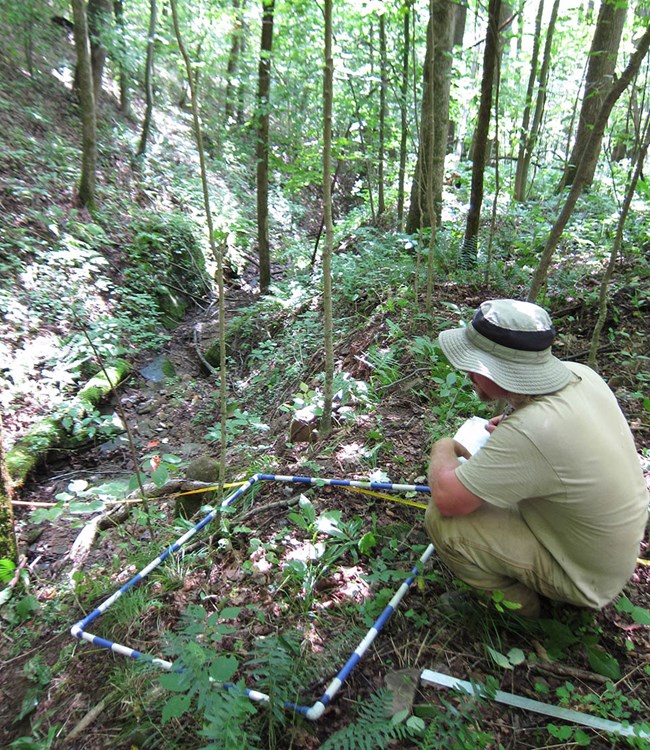Last updated: November 8, 2018
Article
The Future of Our Oak Forests: Can Fire and Fences Sustain Oak Forests for the Future?
Regeneration Failure
Oak-dominated forests are an important resource in the Appalachian Mountains, covering vast areas of the dry ridgetops and mesic hillsides. Within the larger national parks in the Eastern Rivers and Mountains Inventory and Monitoring Network (ERMN), oak forests cover about half of the park (between 42 – 66% depending on the park). However, the future of these forests is uncertain due to the lack of regeneration that would form the future oak trees.

Data from forest health monitoring plots in ERMN parks and numerous other studies in the eastern United States have documented the underrepresentation of oak seedlings and saplings in forests with canopies dominated by oaks (Figures 1 and 2). Disproportionately fewer oaks occur in the forest understory when compared to the forest canopy (Figure 1). This means that as large oaks die, they likely will be replaced by maples that are now common as saplings and seedlings. Given the current trajectory, the parks’ vast areas of oak forest will be replaced by maple-dominated forest decades from now.

Although small (<30 cm tall) oak seedlings are relatively common in ERMN oak forests, taller oak seedlings and oak saplings are rare. Based on an oak sustainability index developed by the US Forest Service, only 4% of ERMN oak forest plots contain sufficient oak regeneration to sustainably replace the canopy (Figure 2).
What Causes Oak Regeneration Failure?
The lack of oak regeneration is influenced by a combination of interacting factors, but is generally attributed to changes in disturbance regimes, especially fire. Historically, periodic surface fires and canopy gaps have worked together to perpetuate oak forests. Chronic browse by white-tailed deer also impedes regeneration by preventing oak seedlings from maturing into saplings (see Figure 1). Other influential factors that may be important to oak regeneration at a local level are soil acidification, exotic pests such as gypsy moth, and invasive plants.
Importance
Forests dominated by oaks support diverse communities of animals and plants. Within the mid-Atlantic region, acorns produced by oak trees are a valuable food resource for more than 50 bird and mammal species and numerous species of invertebrates. Furthermore, oak forests host more species of birds than maple-dominated forests because oak bark, flowers and leaves support more insects that are an important food source for birds.
Canopies of oak trees are penetrated easily by sunlight which facilitates the development of diverse herbaceous and shrub communities on the forest floor. The oak leaves are slow to decompose and are an excellent fuel source for low-intensity surface fires that further diversify forest-floor plant communities.
Management Considerations
Strategic use of prescribed fire (Table 1) and deer exclosure fences can be used by park managers to promote oak regeneration.
Single fires conducted in closed-canopy stands have little impact in the short term, but multiple burns eventually benefit oaks in the long term (Table 1), especially when followed by a canopy disturbance. Fires should be low-intensity and occur in late winter or early spring over multiple intervals (every 3-5 years).
|
Use of Prescribed Fire |
Management Actions |
Burn Objectives |
Considerations |
|---|---|---|---|
|
Site Preparation |
• Spring groundstory fires at multiple intervals (3-5 years) |
• Decrease midstory density |
Multiple burns over a decade or more are needed to positively influence oak regeneration |
|
Release of Established Oak Reproduction |
• Partial harvest canopy to release regeneration of all species |
• Promote oak regeneration |
Requires harvesting canopy trees which may or may not be compatible with park mandates |
Since oak seedlings are shade-intolerant, oak reproduction is often encouraged by partial harvest of the canopy (Table 1). In these open stands where established oak saplings are competing with saplings of mesophytic species, fire can be an excellent tool to promote oak and suppress mesophytic species.

NPS
Currently, most ERMN oak forests are closed-canopy and the vast majority of ERMN oak regeneration occurs as small, suppressed seedlings which may be killed by prescribed fire. Installing deer exclosure fencing within portions of the burn unit and also in adjacent unburned oak forest will provide crucial information about the relative impacts of deer browse and fire on regeneration.
Establishing monitoring plots (Figure 3) in the burn units and exclosure fences is crucial to understand the effects of these management actions and to guide future efforts. The establishment of invasive plant species must be monitored and the spread of these species must be controlled to maintain forest health. Canopy disturbance should be considered only at sites that are free of invasive species.
Ecological Monitoring in the Eastern Rivers and Mountains Network
The ERMN monitors forest health in eight national parks in the Appalachian Mountains. ERMN’s larger parks include: Delaware Water Gap National Recreation Area, Gauley River National Recreation Area, New River Gorge National River, and Bluestone National Scenic River. Ecological condition data are collected on canopy trees, tree regeneration, shrubs, plant diversity, downed logs, and soil at 360 permanent plots established in the parks. Monitoring began in 2007 and plots re-visited every five years.
Further Reading
Yuska, A.M., Steiner, K.C., Finely, J.C. 2008. Effects of deer exclosures on oak regeneration in closed-canopy stands. In; Jacobs, D.F.; Michler, C.H., eds. Proceedings, 16th Central Hardwood Forest Conference; April 8-9; West Lafayette, IN. Gen. Tech. Rep. NRS-P- 24. Newtown Square, PA: U.S. Dept of Agriculture, Forest Service, Northern Research Station. 595 p.
Brose, P.H., Dey, D.C., Philips, R.J., Waldrop, T.A. 2013. A meta-analysis of the fire-oak hypothesis: does prescribed burning promote oak reproduction in eastern North America? Forest Science 59(3): 322-334.
Rankin, W.T.; Herbert, N. 2014. Restoration in the Southern Appalachians: a dialogue among scientists, planners, and land managers. Gen. Tech. Rep. SRS-189. Asheville, NC: U.S. Department of Agriculture Forest Service, Southern Research Station. 48 p.
For More Information
Stephanie Perles
Ecologist, Project Lead
Forest Vegetation & Soils Monitoring
814-441-9643
stephanie_perles@nps.gov
Eastern Rivers & Mountains Network
420 Forest Resources Building
University Park, PA 16802
Summary by the Eastern Rivers & Mountains Network, April 2011.
Tags
- bluestone national scenic river
- delaware water gap national recreation area
- gauley river national recreation area
- new river gorge national park & preserve
- im
- ermn
- vital sign
- monitoring
- vegetation
- forests
- forest health
- oak
- maple
- forest management
- forest regeneration
- regeneration
- prescribed fire
- prescribed burns
- deer
- exclosure
- exclusion fence
